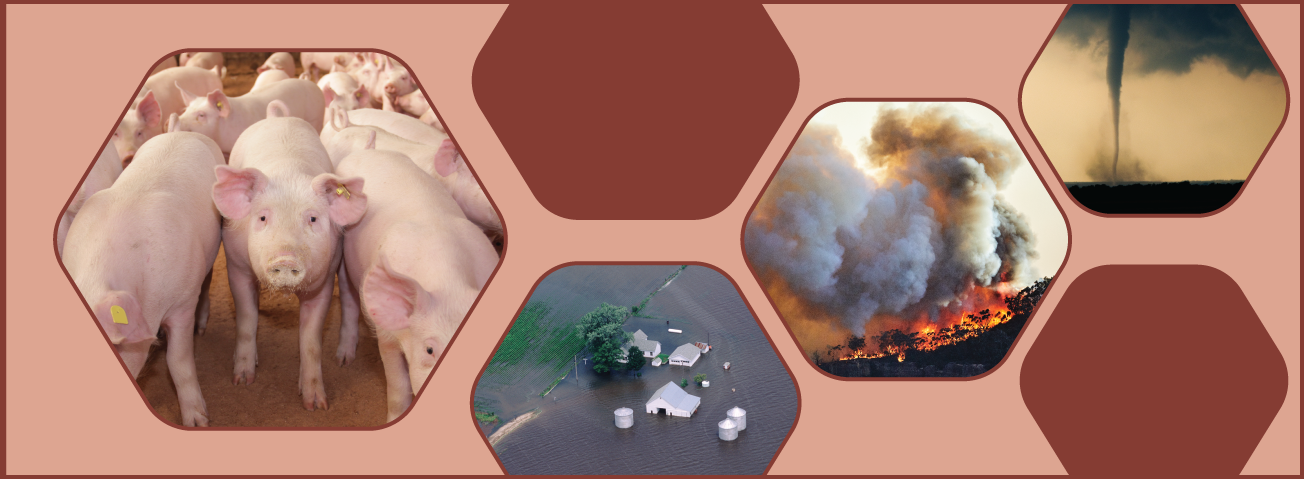
Study Links Federally Declared Weather Disasters to Reductions in U.S. Pork Processing
- by Samantha Padilla
- 4/8/2024
The number of weather disasters and their cost to the economy are increasing in the United States, according to the National Oceanic and Atmospheric Administration (NOAA). In 2022, damages from weather disasters totaled $165.1 billion, compared with $54.1 billion in 2019, NOAA data show. The agricultural sector is particularly susceptible to challenges caused by extreme weather and environmental events such as wildfires, snowstorms, or hurricanes. For example, drought has contributed to recent declines in the beef cow inventory, and crop sales in Puerto Rico decreased $82 million after hurricanes Irma and Maria.
Federally declared weather disasters not only affect crop and livestock production, they also can challenge entities further down the food supply chain, such as meat processors. When an area experiences a disaster, it can be more difficult for a meat processing plant to operate efficiently. For example, it might be harder to transport hogs from farms to processing plants because of poor weather and road conditions. Plant workers might have trouble commuting in severe snowstorms. Environmental disasters, outbreaks of illness, and consistent population loss in areas surrounding a packing plant—all of which indirectly impact labor availability—have the potential to reduce or halt production.
Researchers from USDA, Economic Research Service and Iowa State University studied which factors were more likely to influence a pork processor’s decision to reduce slaughter volumes. They used 2020–21 slaughter data and location information from the Nation’s 40 largest pork plants, which together accounted for about 90 percent of the volume of U.S. federally inspected hogs that were slaughtered in that period. The researchers determined that the presence of a federally declared weather or environmental disaster increased the chance of reduced slaughter volumes and the size of the reduction, as well as the probability of plants shutting down.
The probability of a reduction in slaughter volume for an individual plant increased 11 percentage points when the Federal Government issued a disaster declaration. Similarly, a plant was 13 percentage points more likely to shut down if there was a severe weather event. When a disaster was present and the plant remained open, slaughter decreased an average of more than 4,000 hogs per day, which would be close to 40 percent of the average daily slaughter for the plants sampled in the researchers’ study.
The research team also examined the interaction between plant capacity (a measure of plant size) and the occurrence of a disaster to get a sense of the vulnerability of packing plants. The researchers determined that if a disaster occurred, pork plants with higher processing capacity would experience slightly larger reductions in slaughter than smaller plants. Even so, the reductions represent a smaller percent of the total processing capacity for larger plants.
This article is drawn from:
- Padilla, S. L., MacLachlan, M.J., Vaiknoras, K. & Schulz, L.L. (2023). Disasters, population trends, and their impact on the U.S. pork packing sector. Food Policy.
You may also like:
- Kenner, B., Russell, D., Valdes, C., Sowell , A., Pham, X., Terán, A. & Kaufman, J. (2023). Puerto Rico’s Agricultural Economy in the Aftermath of Hurricanes Irma and Maria: A Brief Overview. U.S. Department of Agriculture, Economic Research Service. AP-114.
- Knight, R., Brooks (Taylor), H., Hahn, W., Terán, A., Haley, M., Grossen, G., Valcu-Lisman, A., Collins, L.A. & Oerly, A.K. (2023). Livestock, Dairy, and Poultry Outlook: March 2023. U.S. Department of Agriculture, Economic Research Service. LDP-M-345.
- Understanding the link between climate change and extreme weather. (2021). U.S. Environmental Protection Agency.
- Smith, A. (2023). 2022 U.S. billion-dollar weather and climate disasters in historical context. Beyond the data, NOAA Climate.gov, National Oceanic and Atmospheric Administration, National Centers for Environmental Information.


